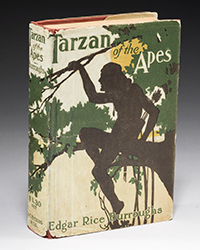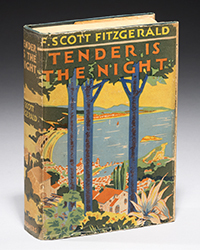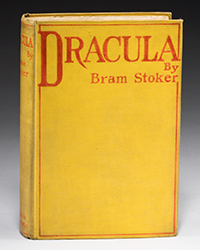Most AE Monthly readers know Bruce McKinney as founder of the American Exchange and its impressive database of book auction records (AED); but the 66-year-old bibliophile also has an impressive record as a collector. In 2009 and 2010 two of his personal collections of early Americana sold at auction for a combined total of over $7 million.
McKinney calls his current collecting focus “An Upstate New York State of Mind.” It comes from the days when America was “tall and narrow” and the emerging nation clustered along the East coast. A small portion of his extensive holdings was on view recently at his home in San Francisco in conjunction with the February ABAA Antiquarian Book Fair.
Attending the special event were about 40 members of the Grolier and the Roxburghe Club of northern California who took a self-guided ramble through three floors of interesting and visually unusual materials consisting not only of books but paintings, maps, broadsides, prints, flags, models and ephemera of all sorts. McKinney estimated he has collected upwards of 3,000 items. “And,” he added, “When I say I have two hundred watercolors by a particular artist, well, that counts as one in the inventory.”
He dates his interest in collecting to 1955, when at the age of 9, his mother advanced him $4 to invest in book acquisitions (“That was a lot of money for a kid back then.”) and sent him on a visit to local historian Bill Heidgerd who advised that there was a future in local imprints.
A native of upstate New York himself, McKinney was a successful businessman both at home and abroad. His many ventures have been as diverse as publishing the Orange County (NY) Free Press in the early 1970s, organizing several firms to act as Asian trade broker in Taiwan, Hong Kong and Korea; the development of Tradex Orient in Hsinchu, Taiwan as an important Disa-based source for quality castings, the building of Consolidated Dutchwest in the United States into a national woodstove retailer in the 1980s. The financial rewards of these enterprises enabled him to take early retirement. Since, after becoming an asset manager, he has invested some of his resources in his enthusiasms for a variety of subjects. He identified “the last fifteen years, since the advent of the internet” as banner years for collectors.
In his opinion, those with a very specific focus, such as the Hudson River Valley – have been able to access a much broader spectrum of material besides the printed page on sites such as eBay. He finds these new tools “encouraging.” And of course it doesn’t hurt the quest at all that he keeps millions of book auction records in the basement. For his own interest and the interest of other collectors he reiterated that the AED (Americana Exchange Data Base) is the largest source of pricing and valuation for the field ever undertaken. “I’ve built and continue to build the database I need to collect intelligently.”
It was clear to visitors that he’d put a significant amount of time and effort into the display. The entire home served as a gallery for prime examples from his holdings and guests had the benefit of an 87 item dated checklist to use in the self-guided tour.
Asked to comment on a few of the remarkable items on display McKinney put the period in context. “There was a moment when the Hudson River was the Broadway of American commerce,” he said pointing out that the area has some of the most continuously occupied real estate in the country. In the early 19th century, before the advent of the railroad, the steamer and canal boat were the dominant modes of transporting goods and passengers. Though the display included items both earlier and later the focus is on this era.



![<b>Sotheby’s, Dec. 11:</b> Darwin and Wallace. On the Tendency of Species to form Varieties..., [in:] <i>Journal of the Proceedings of the Linnean Society,</i> Vol. III, No. 9., 1858, Darwin announces the theory of natural selection. £100,000 to £150,000. <b>Sotheby’s, Dec. 11:</b> Darwin and Wallace. On the Tendency of Species to form Varieties..., [in:] <i>Journal of the Proceedings of the Linnean Society,</i> Vol. III, No. 9., 1858, Darwin announces the theory of natural selection. £100,000 to £150,000.](https://ae-files.s3.amazonaws.com/AdvertisementPhotos/00d5fd41-2542-4a80-b119-4886d4b9925f.png)






![<b>Heritage, Dec. 15:</b> John Donne. <i>Poems, By J. D. With Elegies on the Author's Death.</i> London: M[iles]. F[lesher]. for John Marriot, 1633. <b>Heritage, Dec. 15:</b> John Donne. <i>Poems, By J. D. With Elegies on the Author's Death.</i> London: M[iles]. F[lesher]. for John Marriot, 1633.](https://ae-files.s3.amazonaws.com/AdvertisementPhotos/8caddaea-4c1f-47a7-9455-62f53af36e3f.jpg)




















